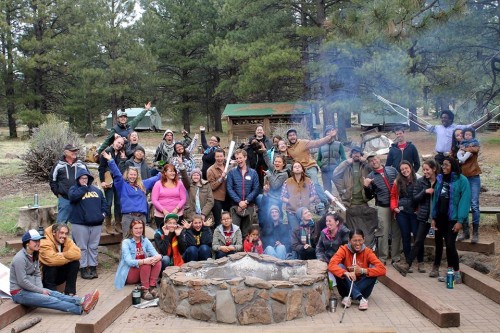Uplift: Youth in Action for the Colorado Plateau

One of the pillars of North Cascade Institute and Western Washington University’s M.Ed. graduate program is a “sense of place.” This can be hard to define, but often includes an understanding of the natural landscape, knowledge of cultural history, and the feeling of community. Over the past nine months, the mountains of the North Cascades and the shore of Diablo Lake have become a second (or third, or fourth) home. There is another place that has always felt like home: the Colorado Plateau. The Colorado Plateau is a 130,000 square mile area that spans parts of Arizona, New Mexico, Utah, and Colorado. It is home to ten National Parks, 17 National Monuments, the Colorado River, and mountains standing up to 11,000 feet high.
The Colorado Plateau gave me my most rewarding employment and confirmed for me that I am destined for a life outdoors and many years of teaching. It was there that I first developed a deep connection with land and learned innumerable lessons about myself. So, I when I heard about the Grand Canyon Trust holding a conference in mid-April, I knew I had to go. With the blessing of all the staff at North Cascades Institute, I flew to Flagstaff, AZ on April 17th.
Uplift: Youth in Action for a More Just and Sustainable Plateau was a gathering of youth, ranging in age from 17 to 30, sharing passion, vision, and strategies for protecting the Colorado Plateau. The conference drew many Diné (or Navajo) from the nearby reservation, as well as young activists and students from as far away as Washington, DC, Montana, and Bellingham (yours truly!) We traveled from our various corners of the country to Camp Colton, located about 15 miles north of Flagstaff in Coconino National Forest.
The conference opened with a call to arms by Diné activist Klee Benally whose extensive activism has recently centered around the Arizona Snowbowl. The Snowbowl has sparked much controversy due to their use of treated sewage, which remains untested for the presence of hormones and several toxic chemicals, to make snow. The park was also built in the San Francisco Peaks, where many sites sacred to the Diné and Hopi peoples are located.
The weekend continued with a series of workshops including “Wilderness and Wildness,” “Nonviolent Direct Action,” “Protecting Wild Utah,” “Plant Propagation for Restoration and School Gardens,” “Just Transition and Restorative Economy,” “Film as a Tool for Advocacy” and “Navigating the Federal Bureaucracy.” Many conservation organizations, including Southern Utah Wilderness Alliance, Grand Canyon Wildlands Council, and Sierra Club were represented at the conference as both workshop leaders and attendees.The conference standouts for me, however, were the speakers. Alongside Klee Benally were Diné activists Nicole Horseherder (co-founder of To Nizhoni Ani, or “Beautiful Spring Speaks,”) and Jason Nez and Renae Yellowhorse of Save the Confluence.
With a background in linguistics, Nicole Horseherder spoke to her experience with fighting against companies like Peabody Energy whose coal plants and mining projects threaten the already scarce and precious water reserves of the Diné nation. She acknowledged the shifting baseline that occurs across many reservations: a young generation of indigenous youth who believe the reservation has always been as it is now – dry and seemingly barren. She reminisced about the knee-high grass she used to run through and the seeps and springs that characterized the landscape.
Jason Nez and Renae Yellowhorse gave the keynote address on Saturday evening. Their organization, Save the Confluence, is dedicated to mobilizing efforts to prevent the Escalade Project in Grand Canyon. The Escalade Project is a $1 billion proposal by Italian developers that would construct a complex of restaurants, hotels, an elevated river walkway, and an aerial tram at the Grand Canyon, just outside of the National Park boundary. Aside from the effects on the natural beauty of the area, the proposed complex would be located at the confluence of the Colorado and Little Colorado Rivers: the place in many indigenous traditions where mankind emerged from the underworld.
The Colorado Plateau represents an incredible intersection of indigenous communities, ecosystems, waterways, and awe-inspiring public lands. I could not possibly list all the treasures there, nor all the places within the Colorado Plateau that make my heart sing. I left this conference with a renewed sense of outrage for the threats to our national public lands, and a reinvigorated passion for conservation.
I leave you with this short video, made by Justin Clifton.

